Match the following sexually transmitted diseases (Column - I) with their causative agent (Column - II) and select the correct option.
A B C D
(1) (ii) (iii) (iv) (i)
(2) (iii) (iv) (i) (ii)
(3) (iv) (ii) (iii) (i)
(4) (iv) (iii) (ii) (i)
The function of copper ions in copper releasing IUD’s is
| 1. | they suppress sperm motility and fertilising capacity of sperms |
| 2. | they inhibit gametogenesis |
| 3. | they make uterus unsuitable for implantation |
| 4. | they inhibit ovulation |
Which of the following approaches does not give the defined action of contraceptive?
| 1. | Intra uterine devices - Increase phagocytosis of sperms, suppress sperm motility and fertilising capacity of sperms |
| 2. | Hormonal contraceptives -Prevent/ retard entry of sperms, prevent ovulation and fertilisation |
| 3. | Vasectomy - Prevents spermatogenesis |
| 4. | Barrier methods -Prevent fertilisation |
In context of amniocentesis, which of the following statement is incorrect?
1. It is used for prenatal sex determination
2. It can be used for detection of down syndrome
3. It can be used for detection of cleft palate
4. it is usually done when a woman is between 14-16 weeks pregnant
Hysterectomy is surgical removal of
1. uterus
2. prostate gland
3. vas deference
4. mammary glands
Which of the following is not a sexually transmitted disease?
1. Syphilis
2. Acquired Immuno-Deficiency Syndrome (AIDS)
3. Trichomoniasis
4. Encephalitis
One of the legal methods of birth control is
1. abortion by taking an appropriate medicine
2. by abstaining from coitus from day 10-17 of the menstrual cycle
3. by having coitus at the time of day break
4. by a premature ejaculation during coitus
Which of the following cannot be detected in a developing foetus by amniocentesis?
1. Klinefelter's syndrome
2. Sex of the foetus
3. Down's syndrome
4. Jaundice
What is the figure given below showing particular?

1. Ovarian cancer
2. Uterine cancer
3. Tubectomy
4. Vasectomy
The permissible use of the technique amniocentesis is for
1. detecting sex of the unborn foetus
2. artificial insemination
3. transfer of embryo into the uterus of a surrogate mother
4. detecting any genetic abnormality







